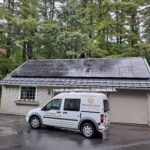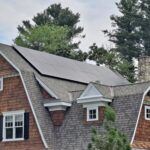 While volunteering with GRID Alternatives in Oakland, California, we worked as Team Leaders on one job which was staffed by about 20 college students from Kansas U. spending their spring break doing volunteer work and learning about green industries around the San Francisco and Oakland area. The spring breakers spent two days working with us and three GRID staffers on a 2 kW solar electric system built on a Habitat for Humanity home.
While volunteering with GRID Alternatives in Oakland, California, we worked as Team Leaders on one job which was staffed by about 20 college students from Kansas U. spending their spring break doing volunteer work and learning about green industries around the San Francisco and Oakland area. The spring breakers spent two days working with us and three GRID staffers on a 2 kW solar electric system built on a Habitat for Humanity home.
As we drove to the job site early the first morning, we were excited about the opportunity to pass some solar knowledge to these kids, and to show them how enthusiastic we all were about helping lower income families reduce their electric bills in a clean and green way. What we didn’t expect was that we’d be working on a 3-story roof or that most of the kids hadn’t been on a ladder before!
After the morning huddle for introductions, the safety chat, and goals for the day, we extended a 32-foot ladder to its limit. There is no doubt a climb like this (and especially the last big step from ladder to roof) is a little unnerving for even some of the saltiest veterans. Roofers and electricians work in two of the most dangerous jobs there are. In solar, we combine the dangers of both professions!
At a job like this, with an all-rookie crew, the keys are to go slow and think before you do anything. There’s also some value when you’re high up on a ladder or roof to seeing the quiet confidence of the people who do it for a living. In other words, we had to make sure that the kids took their cues from us and knew that if we were unfazed while minding our step and watching each other’s backs, they’d be ok too.
Of course, it’s not all in your head! We made sure that everyone going up on the Roof Crew was wearing a safety harness tethered to anchors above. Worst case, if there was a tumble, the harness would arrest your fall… not the ground.
It’s not only the tripping and falling that can be problems when working in solar. We’re also using tools, most of which could hurt you, and dealing with high voltage DC. The key is to take it slow, wear eye protection when needed, and assume all wires are “hot”.
We had two great days of work in the beautiful California sun and all learned a lot from each other. We got everyone up on the roof at one point or another, all got our hands dirty, and gave a lucky family the ability to use that free sunlight to power their home.








Pingback: Tweets that mention Safety First: How to Keep 20 “Green” Volunteers Happy, Learning, and Intact! — BRIGHTSTAR SOLAR -- Topsy.com
Your article helped me a lot, is there any more related content? Thanks!
Thank you for your sharing. I am worried that I lack creative ideas. It is your article that makes me full of hope. Thank you. But, I have a question, can you help me?
Your article helped me a lot, is there any more related content? Thanks!
Thank you for your sharing. I am worried that I lack creative ideas. It is your article that makes me full of hope. Thank you. But, I have a question, can you help me?
Your article helped me a lot, is there any more related content? Thanks!
Informative article, totally what I wanted to find.
Here is my homepage … nordvpn coupons inspiresensation
Incredible! This blog looks just like my old one!
It’s on a entirely different topic but it has pretty much
the same page layout and design. Excellent choice of colors!
Feel free to surf to my web blog; nordvpn coupons inspiresensation
nordvpn 350fairfax
I have read so many posts about the blogger lovers however this piece of writing is
really a fastidious paragraph, keep it up.
Check out my site – nord vpn promo
Your point of view caught my eye and was very interesting. Thanks. I have a question for you.
Your point of view caught my eye and was very interesting. Thanks. I have a question for you.